Marek’s Disease
Marek's Disease (MD) is a neoplastic disease of poultry caused by oncogenic alphaherpesvirus infection. Marek's disease virus (MDV) has a very ubiquitous distribution and is highly resistant to environmental conditions therefore virtually all birds are exposed to strains of MDV during their life, and therefore are infected. But only in a few cases the disease will develop. The infection that occurs in birds is persistent and can be infected for life. The virus infects lymphocyte cells which in some cases will be transformed into tumor cells and infiltrate different organs and tissues of the animal.
Marek's Disease can occur with different clinical presentations:
|
|
MAREK'S DISEASE CLINICAL FORMS |
| Nervous | Usually unilateral flaccid paralysis of the legs or wings is observed. In this case, tumor cells infiltrate the peripheral nervous system, especially the sciatic nerve (neurolymphomatosis). |
| Visceral | Mortality drip and sometimes diarrhea. At necropsy the presence of tumors in different organs is revealed. The most common are liver, proventriculus and spleen. |
| Flaccid neck | Transient flaccid neck paralysis is observed on the birds. Forcing them to lay with their necks stretched on the floor. Usually associated with infection with highly virulent strains ("very virulent plus") MDV (vv+ MDV). |
Given the ubiquity and strength of the virus, vaccination is usually performed on the 1st day of life in hatchery to prevent the infection of the chicks. However, the effectiveness of the vaccine depends on various factors:
|
|
FACTORS INFLUENCING VACCINE EFFICACY |
| Pathotype | Different strains of Marek exist: the virulent strains ("virulent" - v MDV), the highly virulent ("very virulent" - vv MDV) and highly virulent plus ("very virulent plus" - vv+ MDV). Among other things strains vv+ MDV and vvMDV are characterized by being able to break the immunity generated by Marek vaccines HVT and bivalent . Here we do not know what field pathotypes are present but the flaccid neck clinic observed on some farms is associated with vv+ MDV strains, therefore probably these strains are circulating. |
| Serotype | Also there are different serotypes of Marek (1, 2 and 3). Most common vaccines are HVT (serotype 3) or Rispens CVI988 (serotype 1) and there are some combined vaccines. CVI988 vaccine seems that yields best protection against vv+ MDV. The HVT gives good protection against virulent strains, and in combination with strains of serotype 2 strains against vvMDV. |
| Genetics | There is also genetic genetic effect: some strains are more susceptible to Marek others. |
| Conservation | Marek's vaccine is stored frozen in liquid nitrogen and its management in hatchery must be very good because the title of the vaccine drops very quickly. |
| Regime | To further complicate the issue, since birds are nowadays slaughtered very soon, in many cases they have no time to develop disease, and it is common not to vaccinate full dose. In fact most of the Marek cases seen in slaughterhouse are usually in slower growing birds. |
ANTEMORTEM: The signs depend on the clinical condition of the animals, paralysis of the limbs or neck flaccid paralysis can be seen.
POSTMORTEM: Lesions can include thickening, usually unilateral, of the sciatic nerve, nodular lesions in the viscera, thickening of the proventriculus wall, splenomegaly and the presence of perifollicular skin nodules.
LABORATORY DIAGNOSIS: MD diagnosis should not only confirm the disease but must rule out other birds neoplastic syndromes such as avian leukosis. This can be done by a histopathological study; therefore tissues to be sent (send samples in formalin) should include those that allow us to distinguish between the two diseases. Samples: sciatic nerve, skin, brain and bursa. Also send tissues or organs that are affected (liver, spleen, proventriculus, etc).

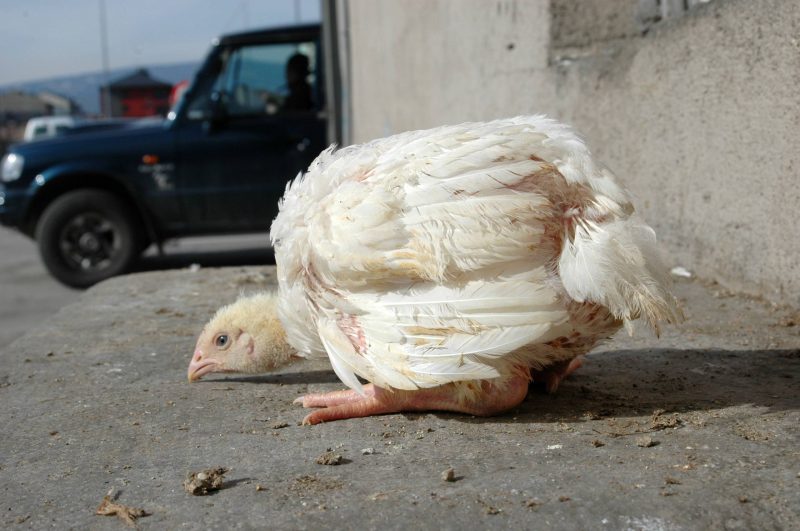
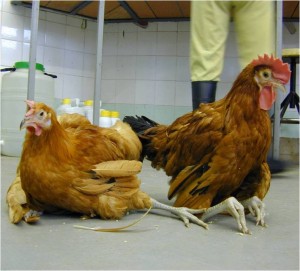
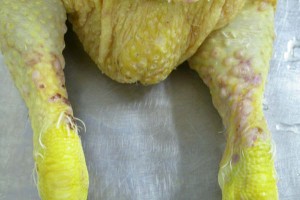
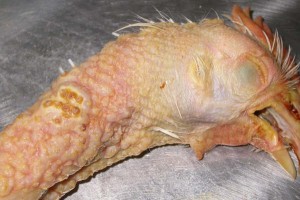
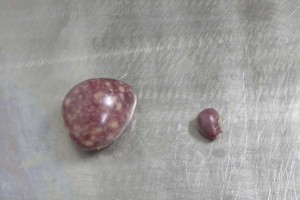
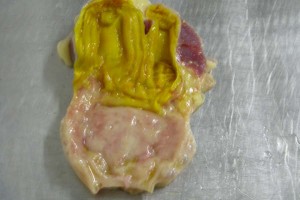


25 comment(s)
Buenas noches , tengo gallinas y dos de ellas se contagiaron del marek , las sacrificamos . Mi consulta es ¿si el resto de aves esta contagiada? , ya que no han recibido la vacuna . Gracias .
¿Las gallinas también pueden presentar la cola caída y la cara pálida debido al Marek?
¿puede afectar a las personas?
Buenos días, la enfermedad de Marek no es una zoonosis, no afecta a las personas.
Quisiera saber si a los patos de casa tambien les da esta enfermedad, porque mis patos de 2 meses caminan un poco y Se sientan doblan sus patas y tiemblan sólo quieren estar sentados, pero si comen bien. por favor ayúdame.
El virus que causa la Enfermedad de Marek es un alfaherpersvirus, específico de pollos, pavos y codornices. Aunque otras aves, como lo patos, pueden ser portadoras, estas no sufren la enfermedad.
Que medicamento le puedo dar a mi gallo que tiene Mareck. Y si es verdad que lo tengo que sacrificar
La vacunación (básicamente a nivel de incubadora) es la única estrategia para el control y prevención de la Enfermedad de Marek.
A pollitas de 3 meses les puede dar el marek si es que no han recibido la vacuna en la incubadora
La forma aguda de Marek si que puede aparecer a los 3-4 meses. La forma clásica normalmente aparece a los 5-6 meses.
Y hay alguna Cura para esto o ya es irreversible?
La vacunación (básicamente a nivel de incubadora) es la única estrategia para el control y prevención de la Enfermedad de Marek.
Buenas tardes, el virus marek puede contagiar humanos????
Y si es asi, ¿ cuales son los sintomas que presenta el ser humano?
Porfavor, necesito esa informacion.
ES URGENTE!!!.
El virus de Marek no afecta a las personas.
Buenos días quisiera saber si el consumo de huevos de gallinas con la enfermedad de marek, es perjudicial para la salud humana.
Buenos días, la enfermedad de Marek no es una zoonosis, no afecta a las personas.
Se puede consumir la carne del gallo con marek o no
La Enfermedad de Marek no es una zoonosis, es decir que no se transmite a las personas. Pero la normativa exige retirar del consumo todas aquellas canales con evidencias de enfermedad generalizada.
quisiera saber si afecta a las personas al consumir el ave o si se puede contagiar y afectar la vista
El Virus de Marek no afecta a las personas.
He buscado esa vacuna en varias veterinarias y no la puedo conseguir, unicamente venden la triple aviar, newcastle y viruela, como sera q la puedo conseguir para mis animalitos ya q han presentado estos sintomas
Que remedio hay para combatir la enfermedad de marek?
La vacunación (básicamente a nivel de incubadora) es la única estrategia para el control y prevención de la Enfermedad de Marek.
Mi consulta es que tengo unos pollitos de 2 meses y medio, con problemas de ceguera sus pupilas se ponen blanco cristalino, pero están normal, gorditos comen bien a pesar que estan con la ceguera cual puede ser los problemas que presentan mis aves.
La lesión que describes (ojo blanco) puede significar que tus aves tienen o bien una ulcera corneal o hipopion (pus en la cámara anterior del ojo). Aunque si realmente están ciegos no deberían de comer normalmente.
Si se trata de úlceras puede ser por un exceso de amoníaco en el ambiente (por falta de ventilación) el hipopion está causado por una infección bacteriana secundària (que también podría ser secundaria a la úlcera).